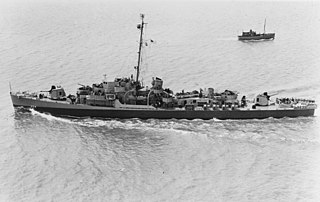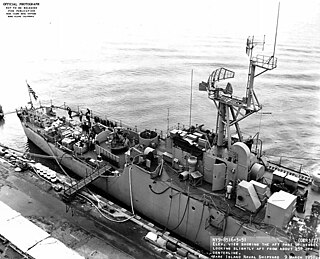
USS Herbert (DD-160) was a Wickes-class destroyer. She was named for Hilary A. Herbert (1834–1919), Secretary of the Navy from 1893 to 1897.

Mahan-class destroyers of the United States Navy were a series of 18 destroyers of which the first 16 were laid down in 1934. The last two of the 18, Dunlap and Fanning, are sometimes considered a separate ship class. All 18 were commissioned in 1936 and 1937. Mahan was the lead ship, named for Rear Admiral Alfred Thayer Mahan, an influential historian and theorist on sea power.

USS Howard (DD–179), (DMS-7) was a Wickes-class destroyer in the United States Navy during World War II. She was named for Charles W. Howard, who was killed in the American Civil War aboard USS New Ironsides.

USS Rudderow (DE-224) was the lead ship of her class of destroyer escorts, in service with the United States Navy from 1944 to 1947. After spending decades in reserve, she was sold for scrap in 1970.

USS Naifeh (DE-352) was a John C. Butler-class destroyer escort in service with the United States Navy from 1944 to 1960. She was sunk as a target in 1966.

USS Dufilho (DE-423), was a John C. Butler-class destroyer escort.

USS George (DE-697) was a Buckley-class destroyer escort. She was the second ship of the United States Navy named after Seaman Second Class Eugene F. George (1925–1942), who was posthumously awarded the Navy Cross for his heroism on USS San Francisco at the Naval Battle of Guadalcanal.

USS Jobb (DE-707) was a Rudderow-class destroyer escort in service with the United States Navy from 1944 to 1946. She was sold for scrap in 1970.

USS Weeden (DE-797) was a Buckley-class destroyer escort in service with the United States Navy from 1944 to 1946 and from 1950 to 1958. She was scrapped in 1969.

USS Loy (DE-160/APD-56), a Buckley-class destroyer escort in service with the United States Navy from 1943 to 1947. She was converted to high-speed transport (APD) in late 1945. Following her decommissioning, she spent another 19 years in reserve before being sold for scrap in 1966.

USS Manning (DE-199) was a Buckley-class destroyer escort in service with the United States Navy from 1943 to 1947. She was scrapped in 1969.

USS Gunason (DE-795) a Buckley-class destroyer escort of the United States Navy, was named in honor of Lieutenant Robert W. Gunason who was killed in action while serving on USS Astoria during the Battle of Savo Island.

USS Harold C. Thomas (DE-21) was an Evarts-class destroyer escort constructed for the United States Navy during World War II. It was promptly sent off into the Pacific Ocean to protect convoys and other ships from Japanese submarines and fighter aircraft. At the end of the war, she returned to the United States with two battle stars.

USS Canfield (DE-262) was an Evarts-class destroyer escort constructed for the United States Navy during World War II. She was sent off into the Pacific Ocean to protect convoys and other ships from Japanese submarines and fighter aircraft. She performed escort and antisubmarine operations in dangerous battle areas and returned home with four battle stars.

USS Joyce (DE-317) was originally commissioned as a US Coast Guard Edsall-class destroyer escort built for the U.S. Navy during World War II. She served in the Atlantic Ocean and the Pacific Ocean and provided destroyer escort protection against submarine and air attack for Navy vessels and convoys. During its World War II service, on two different engagements with enemy submarines, the Joyce rescued survivors of the tanker SS Pan- Pennsylvania and its sister ship USS Leopold. Joyce received one battle star for its service during World War II.

USS Lloyd E. Acree (DE-356) was a John C. Butler-class destroyer escort acquired by the U.S. Navy during World War II. The primary purpose of the destroyer escort was to escort and protect ships in convoy, in addition to other tasks as assigned, such as patrol or radar picket.

USS George E. Davis (DE-357) was a John C. Butler-class destroyer escort acquired by the U.S. Navy during World War II. The primary purpose of the destroyer escort was to escort and protect ships in convoy, in addition to other tasks as assigned, such as patrol or radar picket.
USS Johnnie Hutchins (DE-360) was a John C. Butler-class destroyer escort acquired by the U.S. Navy during World War II. The primary purpose of the destroyer escort was to escort and protect ships in convoy, in addition to other tasks as assigned, such as patrol or radar picket. She served in the Pacific Ocean, and, post-war, she returned home with a Navy Unit Commendation awarded to her for her battle with Japanese midget submarines on 9 August 1945.

USS Thomason (DE-203) was a Buckley-class destroyer escort in service with the United States Navy from 1943 to 1946. She was scrapped in 1969.

USS Thomas F. Nickel (DE-587) was a Rudderow-class destroyer escort in service with the United States Navy from 1944 to 1946 and from 1948 to 1958. She was sold for scrapping in 1973.



















